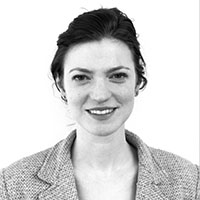Jenny Packham by Emily Shire
I do believe the regal glamour and irreverently preppy attire on display at Jenny Packham’s New York Fashion Week show on Sunday would have charmed me, rain or shine.
However, the fact that the audience was a noticeably less fashionable melange of utilitarian umbrellas and dreary, knee-length, abominable snowmen coats drew a lovely contrast to the fanciful yet edgy ode to British pomp and regality that defined Packham’s designs.
ADVERTISEMENT
When I stumbled into the gallery at Skylight Clarkson Square and nearly took out someone’s eye with my impossible to close umbrella, I realized that this was my first NYFW venture where I actually felt my lack of sartorial commitment matched—or almost matched—the rest of the attendees.
The frigid rain and slushy snow plaguing Manhattan seemed to defeat all but the most devoted fashionistas. However, that meant for the moderately drenched crowd, Packham’s attire, with all their sequins, crystals, and brocade was all the more welcomed.
Titled “The Heritage Collection,” Packham’s 36 outfits were “inspired by the idiosyncrasies and clichés that define the British identity,” according to the press release, which was also accompanied by a card of artist Magda Archer’s “God Bless You Ma’am.”
Archer’s illustration depicts a young Queen Elizabeth in an almost too cool to be proper manner with bold colors and shock of lime green writing. That same saucy (but affectionate) thumb-biting at classic British styles made Packham’s collection so fascinating yet accessible.
The Kinks’ “Village Green Preservation Society” blared as wedgewood blues and tartan patterns abounded—including in a silk chiffon gown and a sexy cocktail dress that was paired with a crimson leather jacket.
In another cheeky nod-and-wink to British culture, a gray satin crepe t-shirt with “Pearly Queen” emblazoned on the front was paired with a silk neckerchief and pearls.
Perhaps the clearest example of Packham’s glamorously chic twist on a British classic was her trench coat. Instead of the typical tan or taupe in poplin or cotton, Packham offered one made of bonded lace brocade in metallic silver, complimented by a bulldog neckerchief.
Even with British “idiosyncrasies and clichés” as a clear guiding theme, the sumptuous embellishments and beading that was just as much present in Packham’s fall NYFW show last September was, thankfully, present in this collection.
A molten silver sequin halter gown evoked the 1970s rock star glamour that rippled through her previous show. A stunning illusion tulle dress was adorned with gunmetal crystals and metallic sequins. My personal favorite may have been a midnight blue crepe gown with gold and ivory crystals.
Yet, even with all the fanciful glamour, all the tulle and the crystals, there is something about Packham’s designs that are delightfully aspirational, if not accessible.
These are not haute couture designs that are more abstract art than actual attire. You may not be able to afford the same gowns worn by the Duchess of Cambridge or Oscar-nominated Viola Davis as she just did for the BAFTA award show this weekend), but you can fantasize about wearing them. And on a miserable, gray winter Sunday in New York City, one could use a good fantasy.
Vaquera by Brea Tremblay
“This crowd is the L train after the Graham stop,” my seatmate murmured. For those of you who are not intimately familiar with the nuances of outer borough public transit in New York, he was talking about neighborhoods where hipsters are so hipster, they are no longer just bringing back vinyl—they’re insisting on bringing back cassettes.
Tonight’s Vaquera show took place in the ballroom of the National Ukrainian Home in the East Village. Downstairs, locals were enjoying borsht.
Upstairs, I watched a woman in an Elizabethan collar and hot pants lounge in the front row and sip a beer while we waited for the show to start. The things people brought to this show were truly delightful—beers and coffee yes, but also a French bulldog. More fashion shows should have puppy guests.
Props continued to be a theme when the lights went down. A toolbox stood in for a purse, a chef’s hat capped the finale dress, and manufacturing-ready yellow rubber gloves were accessorized with a lobster bib tie and a real, dripping bag of ice.
The clothes had a compelling, if unsubtle, interplay of traditionally masculine and feminine fashion. A black-and-white checked skirt combo was paired with Doc Martens while a cropped jacket was matched with a hardhat and classic pumps.
In the show’s literature, Vaquera said their purpose was “a constant exploration of American tropes and how they’re sold to us.”
They went pretty literal with it—a kicky little jacket and a cocktail dress with a ten-foot train were both made of actual flags. And most of the clothes were punctuated by nudity—side boob there, exposed ass here. As a side note, is it just me or are there way more butts out to play this year?
I have not gone a day without seeing full-frontal cheeks. But speaking of, between that nudity and the lobster bibs and American flags and puppies and the beer guzzling, delightfully-dressed hipster weirdos in the front row and the faint smell of Ukrainian food being served downstairs, this show was a great time. God bless this America.
DVF by Tim Teeman
As Jonathan Saunders, the chief creative officer of Diane von Furstenberg, was wearing one of New York Fashion Week’s ubiquitous pink pro-Planned Parenthood badges it seemed reasonable to ask how political he felt the week felt to him.
“No. No politics,” Saunders’s handler said. The handsome Saunders himself looked pained.
Saunders was standing just to the left of a group of models sitting and standing, wearing his third collection since taking creative charge of the label in the middle of last year. A New York Times article made the persuasive case that his efforts to redesign and reconceptualize the DVF image, from the template set down by its same-name founder (married to Barry Diller, chairman of IAC, which owns the Daily Beast) had been one of skill and stealth, with none of the visible fallouts and drama that have characterized other handings-over-of-reins.
Had it been intimidating taking on the label? “Not at all, no,” Saunders, who is originally from Glasgow, Scotland, told The Daily Beast. “I think the brand has a lot of identifiable features about it that kind of make you believe in it.
“It is a believable brand with believable ethos, founded by a woman who believed in creating beautiful clothes that had creativity at their core. This wasn’t solution dressing—plain black dresses—but about mixing bold colors and prints together but still remaining sensual and feminine. Having those tools to work with makes it an easy brand to work on.”
Sunday’s show was set in Sean Kelly’s art gallery, on a windswept drag of 10th Avenue best described as “keep walking till you hit Hell’s Kitchen,” well away from the Fashion Week madness of Clarkson Square.
Guests sipped champagne and chilled water. The models sat on staging blocks, and wore a beautifully tailored clothes that spoke of hippy chic—lots of yellows, oranges and burgundies in layers and swathes—but edged up slightly, and made rockier.
A white skirt with black stripes came with a brown sweater and a candy pink neck-muff. Coats were left loosely hanging, decorated with stripes collar and at the wrist. One covered a red and white geometric-design dress. Leopard print sneaked in subtly to finish off a blue handbag. The boots were mod-sexy: white with gold stripes, or sleek and black with little kerchiefs.
For Saunders, this was an “eclectic mixture of African and Japanese textiles, and that kind of way of girls expressing themselves in an imaginary and creative way. It reminds you of the moment in the 1970s when this brand was founded.”
Saunders said that bias-cut scarves gave outfits the kind of movement that shows why “the eccentricity within the collection is an important, key part of it.”
And on a rainy, grim afternoon in New York, where slate-grey skies and slush lurked outside, his DVF vision proved a sunny, boho blast of paradise.








